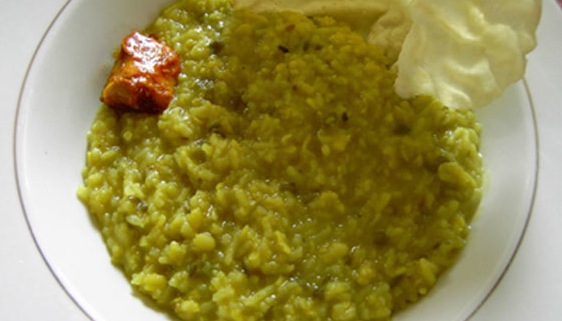Mama’s Punjabi Recipes: Khichdi (Rice & Moong Lentils) Slow Cooker Recipe
Khichdi is a very popular dish, especially if you are short of time, have no ideas for a creative meal or, as is very often the case, just want some comfort food to eat with mango pickle and plain yogurt.
Khichdi is basically made from rice and dal (lentils) and is a relatively cheap meal for a quick burst of carbohydrate energy that many farmers and village folk eat often. It can be made with several types of dals, although the yellow, moong type is the most common. In the Punjab, it is not eaten that often, other than when someone may be feeling an upset stomach.
Khichdi can be made to be thick or really thin and runny, depending on the weather and the people who will eat it – a sick person will probably prefer the runny type. The smell of the basmati rice usually fills the air and will attract people to the stove. But even then, it is often very easy to turn a simple dish into a burnt one if you don’t pay attention to it.
That’s why, as with other dishes that can take a long time to simmer, using a slow cooker to make this simple khichdi dish takes the guessing out of the preparation and you can relax and carry on your other activities. In fact, it is almost as if the slow cooker was made especially for making this simple comfort food. This recipe uses the green sabat moong dal (whole moong dal) which makes the khichdi fluffy and not soft and runny as with yellow, skinless moong dal.
Ingredients:
1 cup basmati chawal (Basmati rice) – you can brown rice if desired
1 cup sabat moong dal (whole moong lentils)
2 cups pani (water)
2 tbspn olive oil
1 medium pyaaz (onion) – peeled and sliced
1 small clump of adrak (ginger) – peeled and sliced
1 medium tamater (tamato) – peeled and sliced
2 small hari mirch (green chillies) – finely chopped
Spices: namak (salt), garam masala, jeera (cumin) – to your taste, haldi (turmeric) is optional
Directions:
1. Place the sabat moong dal in a bowl and wash it thoroughly in cold water and place on the side. Do the same with the basmati rice.
2. Bring 2 cups of water to a boil over high heat and pour into the slow cooker and turn it on. Now pour in the sabat moong dal.
3. Add the oil, onion, ginger, tamato, mirch and salt; stir and cover and let the mixture cook till the dal starts to become tender.
4. Now add the basmati rice. Turn the slow cooker to high and cover. The mixture will start to cook: if you have to leave to run an errand, you can turn the cooker to low, stir it well and got do your work.
5. The khichdi will be ready in two or three hours. When it is ready, turn the slow cooker to warm and the khichdi will stay nicely warm and ready to eat throughout the day. There is no danger of the khichdi getting burnt or spilling over.
6. Before serving, sprinkle the top of the khichdi with garam masala and serve while still hot.
MAMA’S TIP OF THE WEEK
MAKE KADDI OR BOIL MILK IN WIDE PANS TO AVOID BOILING OVER
Many Indian foods rely on using milk as an ingredient, like in making kaddi and especially in making sweets, like rabddi or kheer. When you are making these for a lot of people, it is easy to get distracted while cooking and then the milk can easily boil over and into the stove.
To avoid this problem and allow you to pay greater attention to the other preparations, take advantage of the science behind the cooking utensils and use it for your benefit. Make dishes that have the danger of boiling over in pans with wide openings or in kadais or woks. This will not allow a crust to form on the surface of the milk and let it slowly simmer as it boils. This is the reason many halwais (sweetmeat chefs) in India boil milk in huge cauldrons or praats (woks).
Shakuntla Malhotra is a skilled cook of Punjabi dishes made in the old-fashioned style that she learnt as a young woman in her ancestral home in Lyallpur, India before it became part of Pakistan after the Partition in 1947. People have often admired her cooking for its simplicity and taste that comes with each mouthful. Even in her mid-eighties, she continues to cook daily and agreed to share some of her delectable Punjabi recipes.


